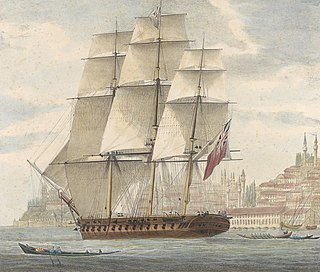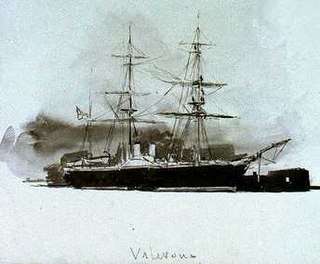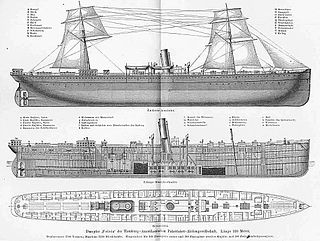
HMS La Hogue was a 74-gun third-rate ship of the line of the Royal Navy, launched on 3 October 1811 at Deptford. She was named after the 1692 Battle of La Hogue. "The La Hogue of 1811 [...] sported a green and chocolate lion, its grinning mouth displaying rows of white teeth and a huge red tongue."

HMS Gorgon was a wooden steam paddle sloop of 6 guns, launched in 1837. In 1840 she took part in the bombardment of Acre, and in 1843 was part of the Royal Navy squadron stationed in the River Plate during the Uruguayan Civil War. She was converted to a troopship and in 1858 assisted Agamemnon in the laying of the first transatlantic telegraph cable. She was sold for breaking in 1864.

HMS Vulture was one of three 6-gun, steam-powered Cyclops-class second-class paddle frigates built for the Royal Navy in the 1840s. She was initially deployed to the East Indies where she participated in actions against China and then played a minor role in the Crimean War of 1854–1855. The ship was sold for scrap in 1863.

HMS St Vincent was a 120-gun first-rate ship of the line of the Royal Navy, laid down in 1810 at Devonport Dockyard and launched on 11 March 1815.

HMS Barham was a 74-gun third rate ship of the line of the Royal Navy named after Admiral Charles Middleton, 1st Baron Barham, launched on 8 July 1811 at Blackwall Yard.

HMS Valorous was one of two 16-gun, steam-powered Magicienne-class second-class paddle frigates built for the Royal Navy in the 1850s. Commissioned in 1853 she played a small role in the Crimean War of 1854–1855 and was sold for scrap in 1891.

The Suffren was a 90-gun Ship of the line of the French Navy, lead ship of her class. She was the third ship in French service named in honour of Pierre André de Suffren de Saint Tropez.

The Tage ("Tagus") was a 100-gun Hercule-class ship of the line of the French Navy.

HMS Belleisle was a 74-gun third-rate ship of the line of the Royal Navy, launched on 26 April 1819 at Pembroke Dockyard.

HMS Formidable was an 84-gun second rate of the Royal Navy, launched on 19 May 1825 at Chatham Dockyard. With a crew of 700 she was one of the Navy's largest ships at that time.

Couronne was a Téméraire class 74-gun ship of the line of the French Navy.

HMS Exmouth was a 91-gun screw propelled Albion-class second-rate ship of the line of the Royal Navy.

HMS Thetis was a 36-gun fifth-rate frigate of the Royal Navy. After nearly a decade of service with the British, she was transferred to Prussia in exchange for two steam gunboats. She served with the Prussian Navy, the North German Federal Navy and the Imperial German Navy as a training ship until being stricken in 1871. Thetis was subsequently converted into a coal hulk and broken up in 1894–95.

HMS Royal Albert was a 121 gun three-decker ship of the Royal Navy launched in 1854 at Woolwich Dockyard. She had originally been designed as a sailing ship but was converted to screw propulsion while still under construction.

HMS Imperieuse (1852) was a wooden screw steam frigate launched in 1852. From 1854 the ship served in the Baltic Sea during the Crimean War.

The SS Silesia was a late 19th-century Hamburg America Line passenger and cargo ship that ran between the European ports of Hamburg, Germany and Le Havre, France to Castle Garden and later Ellis Island, New York transporting European immigrants, primarily Russian, Prussian, Hungarian, German, Austrian, Italian, and Danish individuals and families. Most passengers on this route were manual laborers, including stonecutters, locksmiths, farmers, millers, upholsterers, confectioners, and tailors, though physicians and other professionals also bought passage on her.
HMS Urgent was an iron screw troopship of the Royal Navy. She served her later years as a storeship and depot ship based in Jamaica.

The Duguesclin was a 90-gun Ship of the line of the French Navy. She was the second ship in French service named in honour of Bertrand du Guesclin.

The Saint Louis was a 90-gun Suffren-class Ship of the line of the French Navy. She was the twenty-second ship in French service named in honour of Louis IX of France.

Empire Fowey was a 19,121 GRT ocean liner that was built in 1935 as Potsdam by Blohm & Voss, Hamburg for the Hamburg America Line. She was sold before completion to Norddeutscher Lloyd. While owned by Norddeutscher Lloyd she was one of three sister ships operating the service between Bremen and the Far East. Her sister ships were SS Scharnhorst and SS Gneisenau.


















